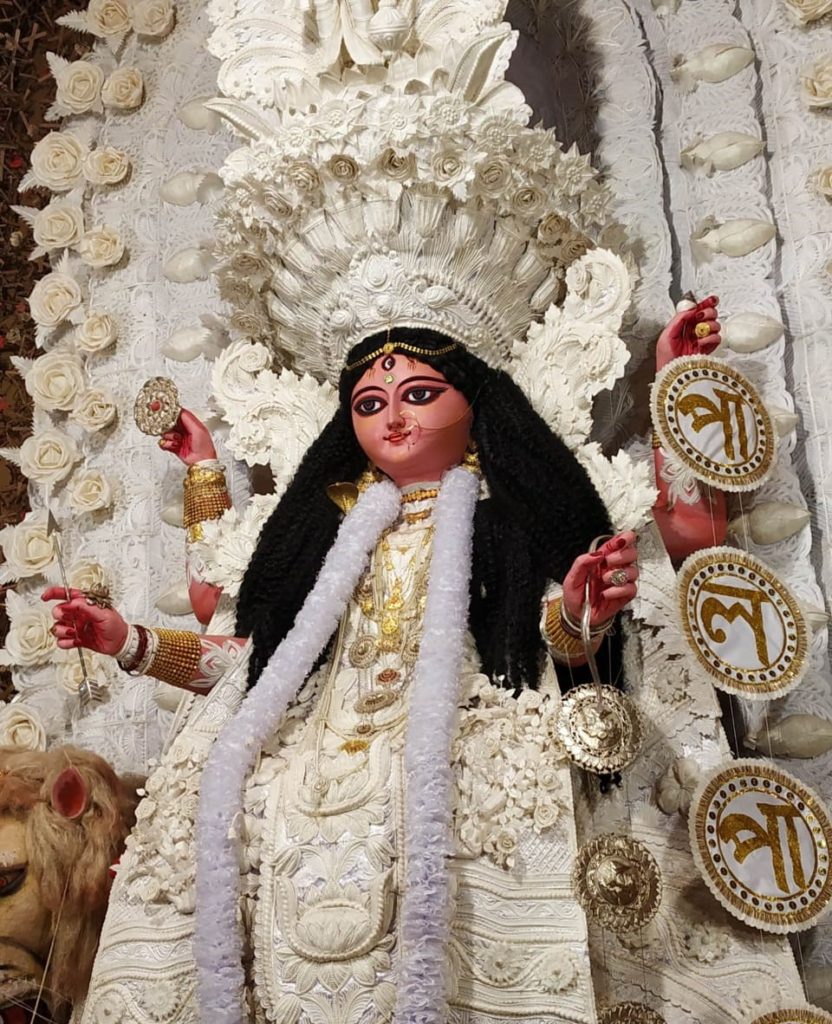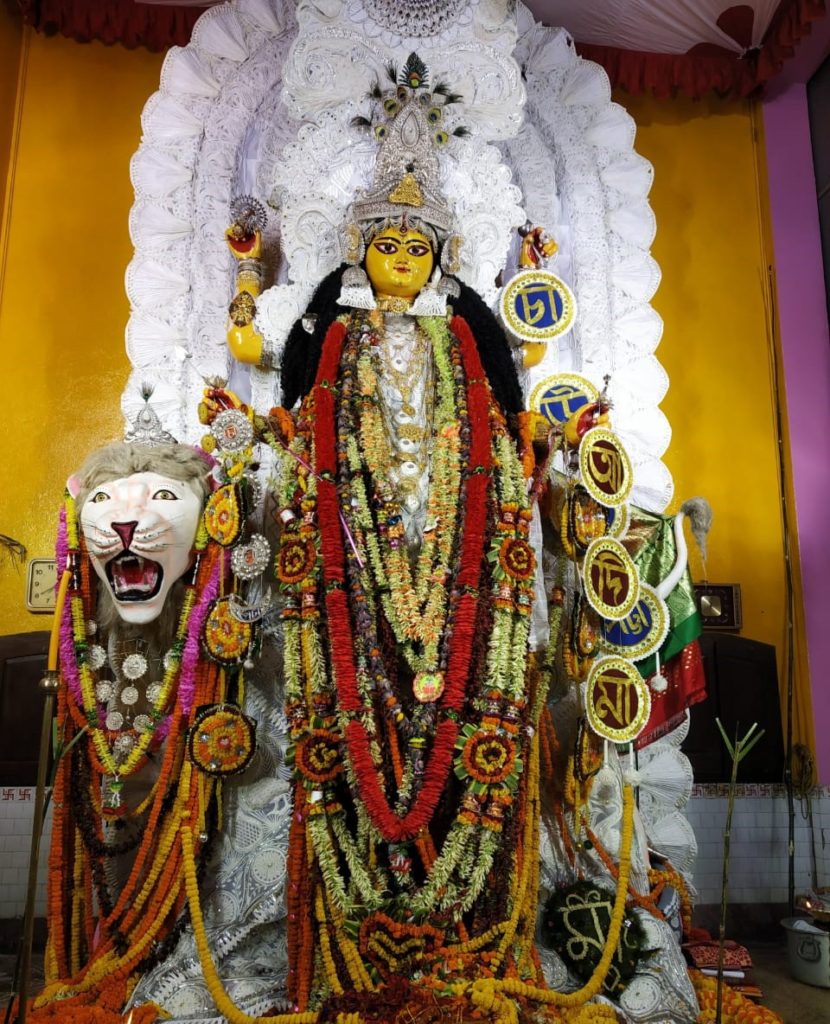
During fall, as the monsoon clouds slowly recede from India, white Kash flowers dot the landscape of Bengal, against the backdrop of calico skies. The festive season begins as Bengal prepares for the biggest festival of the year: Durga Puja. On the tenth day of Puja as bengalis bid a teary farewell to mother Durga and the rest of India lights Ravana effigies, to mark the triumph of good over evil, a few towns of bengal prepare for another festival to be held a month from then- Jagadhatri Puja, just after Diwali. The worshipping of the female energy in Bengal has been a tradition since ages, and the female trinity of Durga-Kali-Jagadhatri conjures up an excellent example. This article seeks to explore the genesis and myths associated with the cult of Jagadhatri.
To explore the origin of this cult, we need to contextualise its birth in the socio-political scenario of Bengal. Bengal was an important province of Mughal India, whose revenue yield went a long way in sustaining the great Mughal treasury. However, there were a number of local rajas opposed to Mughal suzerainty, one of whom was Raja Krishna Chandra Roy of Nadia. Raja Krishna chandra Roy was the Zamindar of Krishnanagar and he belonged to the royal family of Nadia and was an influential man in the Hindu Society, known for his patronage to arts in his kingdom along with the strong resistance he offered to the Mughal rule.
Krishna Chandra Roy was a part of the clique that conspired against Siraj-ud-daullah and brought an end to the Mughal rule with the onset of British rule after the treacherous battle at Plassey (1757). Legend goes that Robert Clive seemed to have met Mir Jafar, Jagat Seth, Omnichund in Krishna Chandra Roy’s house and conspired against the then Nawab of Bengal, Siraj-ud-Daulah. This event is a milestone not only in the history of Bengal but that of the entire India. With Bengal under the British, the Mughal treasury ought to have suffered a great loss, and with the Battle of Plassey, Britain’s colonisation of the mighty Mughal India whose authority and grandeur was decaying gradually was easier. It is interesting to note that Raja Krishna Chandra might not have had concrete intentions for conspiring against the Nawab, but antagonism towards the Mughal rule and promise of political gains which later materialized into a friendly relationship with the british might have been sufficient. He was rewarded with five cannons, the title of maharaja and the zamindari of Krishnanagar.
Allegedly, Raja Krishna Chandra Roy was once captured by a Muslim ruler, and while imprisoned he heard the drum rolls that signaled the tenth or the last day of Puja, and he was filled with grief at his inabiliity to perform puja rituals. He was released shortly after that and on his way home on a boat he had a dream where the Goddess appeared and asked him to worship her as Jagadhatri “in one month, on the ninth day of the bright fortnight in the month of Kartik” (Offering Skulls and Feeding Skeletons: Popular goddess worship in West Bengal by June Mc Daniel). The boat was anchored at Chandannagar and thus began the worship of Jagadhatri in Kapore putty and has since continued approximately for 400 years now.
From Origin myths to today’s celebrations

To understand this cult of Jagadhatri, a brief overview of Durga is needed as Jagadhatri is a manifestation of Durga. The origin and genesis myths are plenty and debatable; there have been claims of her being a bhakti goddess, a folk goddess as well as brahmanical vedic goddess. She has been worshipped in several forms- as fertile female energy, pure energy slayer of evil, as a mother, as a daughter and as an unmarried independent female deity, prevalent in several tribes. However, the lofty status that she is now accorded with has been developed over the ages. The Goddess has been evolving over a period of time, incorporating the traits of several tribal and local deities, a process of integration that is generally characterised by Bhaktism where often with the expansion of state society, local cults were integrated in the courtly cults.
If the legend of Raja Krishnachandra is to be believed then Jagadhatri worship was introduced in the middle of the 18th century, however public worship on a larger scale only began later. It has been argued by certain scholars that Jagadhatri has more tantric associations than Durga whose worship was introduced into tantra in the 15th century. In the well-known tantric compendium of Krishnananda Agamavagisha, Tantrashastra describes Jagadhatri as:
“Riding on a lion, adorned with jewelry, is the four-armed Mahadevi.
She wears a snake as a sacred thread, her two left arms hold a conch and a
bow, and her two right arms hold a wheel and five arrows. She wears red
clothes, and her skin is as red as the early rising sun. Her lotuslike navel is
beautiful in the three folds of her belly, and she sits on a lotus that blooms on
a throne in the island of gems. She is worshiped by sages such as Narada.
Meditate upon that wife of Shiva”
Jagadhatri is a part of Durga, the revered feminine energy, where Durga is a slayer, Jagadhatri is a sustainer. The name Jagadhatri comprises two words: jagat and dhatri which means ‘one who beholds or sustains the earth’ and this name was given to her after she killed Mahishasura the demon as remarked by the Devi Mahatmya in the Markandeya Purana. Jagadhatri is often represented as land and vegetation and in certain places worshipped in the form of an amalaki tree or a twig. In West Bengal some of the oldest pujas are found in Chandannagar where it first originated and in Krishnagar, the home of Krishna Chandra Roy. As a part of the larger Shakta tradition, animal sacrifices are still a part of this Puja, on the ninth day of the festival, where goats are sacrificed as bali. It is interesting to note that in certain places of the town Chandannagar, females are forbidden to take part directly in the rituals and it is only the males who fulfill the role.
The cult of Jagadhatri, mostly remains a local cult however it is quite remarkable how even as a french colony, the Jagadhatri puja was never curbed and rather it was an assimilation of two cultures as french families equally partook in some of the festivities. Thus, though marginalised, Jagadhatri Puja has had a rich tortuous history of evolution and is celebrated with great pomp and show annually in the suburbs of Bengal.
In Chandannagar, Jagadhatri puja is celebrated as the annual festival of its own, surpassing the grandeur of Durga Puja. Acclaimed for its show of lights, during the four days of the Puja the entire town decks up beautifully as food stalls dot its streets and people throng to the pandals. On the last day of Dashami, all the effigies are paraded throughout the town in a night-long procession as the town showcases its skillful craftsmanship of lights and boasts its age-old tradition. The entire town celebrates for five days as monotonous every day routine comes to a halt. As birds turn to their nests when darkness kisses the ground, similarly the town beckons to all who have grown up in its nooks and crannies and migrated to different parts of the country or outside. During these four days as people return to their hometown to celebrate with their loved ones, the entire town state lights up in the warmth and glow of shared joy.
Anushka is currently pursuing her Bachelor's degree in History from St. Stephen's College. To weave stories of the past and strike it's relevance in present times and the times to come is her hobby.



ok so how to do it?. . i have seen people getting their blog posts published on their facebook fan page. pls help . thanks.